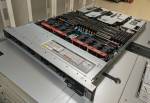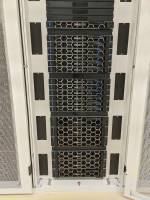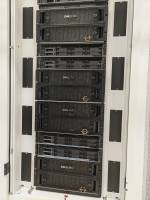Cluster description
The Hábrók cluster has been delivered by Dell and consists of the following parts:
Compute nodes
- 84 standard nodes with the following components:
- 128 cores @ 2.45 GHz (two AMD 7763 CPUs)
- 512 GB memory
- 3.5 TB internal SSD disk space
- 48 nodes for multi-node jobs with the following components:
- 128 cores @ 2.45 GHz (two AMD 7763 CPUs)
- 512 GB memory
- 3.5 TB internal SSD disk space
- 100 Gbps Omni-Path link
- 4 big memory nodes with the following components:
- 80 cores @ 2.3 GHz (two Intel Xeon Platinum 8380 CPUs)
- 4096 GB memory
- 14 TB internal SSD disk space
- 2 Interactive GPU nodes (Delivered by Fujitsu in an earlier purchase) with the following components:
- 24 cores @ 2.4 GHz (two Intel Xeon Gold 6240R CPUs)
- 768 GB memory
- 1 Nvidia L40s GPU accelerator card with 48GB RAM
- 6 GPU nodes with the following components:
- 64 cores @ 2.6 GHz (two Intel Xeon Platinum 8358 CPUs)
- 512 GB memory
- 4 Nvidia A100 GPU accelerator cards with 40 GB RAM
- 12 TB internal SSD NVMe disk space
- 100 Gbps Omni-Path link
- 19 GPU nodes (Delivered by Fujitsu in an earlier purchase) with the following components:
- 36 cores @ 2.7 GHz (two Intel Xeon Gold 6150 CPUs)
- 768 GB memory (621 GB used for temporary disk space)
- 2 Nvidia V100 GPU accelerator cards each with 32 GB RAM
- 621 GB RAM disk
- 15 nodes with the following components:
- 64 cores @ 2.2 GHz (two AMD EPYC 7601 CPUs)
- 512 GB memory
- 16 TB internal disk space
- Only accessible by GELIFES users, see Group specific partition
- 1 node with the following components:
- 64 cores @ 2.1 GHz (two Intel Xeon Gold 6448Y CPUs)
- 1 TB memory
- 440 GB internal disk space
- 4 Nvidia H100 GPU accelerator cards with 80 GB RAM
- Only accessible for education purposes in the scope of the Digital Lab project (employee login required)
see also Group specific partition
- 1 node with the following components:
- 56 cores @ 2.0 GHz (two Intel Xeon Gold 5420+ CPUs)
- 512 GB memory
- 3 TB internal disk space
- 2 Nvidia L40S GPU accelerator cards with 48 GB RAM
- Only accessible for longer jobs, and with higher priority, by users from Computer-Aided Organic Synthesis, see Group specific partition
Network
- A 100 Gbps low-latency non-blocking Omni-Path network for 24 compute and 6 GPU nodes
- High bandwidth (100 Gigabit per second)
- Low latency (few microseconds delay before a client starts receiving the message)
- Useful for parallel processing over multiple computers
- Two 25 Gbps Ethernet networks
- Used for accessing the storage areas and for job communication
- Can also be useful to access remote data more quickly
Storage
- The cluster has 2.5 PB (2562 TB) of formatted storage available. This scratch storage is set up using the Lustre parallel file system.
- 50 GB of home directory storage per user
See Storage areas for more information.
Clock speed and turbo mode
Our standard systems have two sockets with a AMD 7763 processor. Each processor has 64 CPU cores running at 2.45GHz. When not all cores of a processor are used the cores can be run at a higher clockspeed (at most 3.5 GHz).
Hyperthreading
In principle each CPU core of a modern processor can run multiple threads (programs) simultaneously. This is called hyperthreading. This feature has been disabled on most nodes for the Hábrók cluster as the performance benefits are minimal and it introduces additional complexity to the scheduling system and for the user.
Memory access
Each processor has its own memory controllers and is connected to its own set of memory. For our standard systems this means that each processor has direct access to 256 GB of the 512 GB in the system.
When a processor wants to access the memory of another processor it has to use the infinity fabric connections between the processors. This connection is much slower than the connection to the local memory. This means that it is important that processes running on one of the processors use the memory local to that processor!
NOTE You can still request all the memory on a machine, even with a single core. This is extremely inefficient however as most cores are idling and you should really look into parallelizing your workload.




